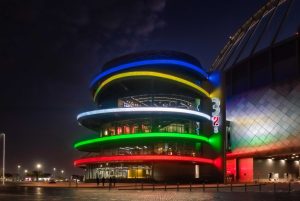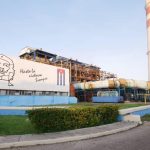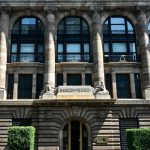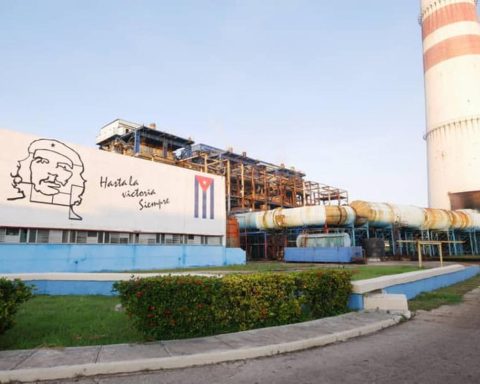Doha, the capital of Qatar, is a modern city completely renovated to host the World Cup and to think that it is a recent and technological city is commonplace, but its museums and galleries hide the essence of its history, traditions and a vast legacy to explore.
A spectacular desert rose of more than 40,000 square meters welcomes the arrival of all the fans and tourists who visit Qatar and who arrive from the airport to the heart of the city through the popular La Corniche avenue, its seaside promenade.
It is the main museum in the country, the National Museum of Qatar, an architectural jewel that heads the surprising cultural offer of a country that has reinvented traditional visits to museums with interactive exhibitions and the latest technological innovations in which the future sets trends.
The work of the French architect Jean Nouvel, winner of the Pritzker Prize, this monumental building evokes the tradition and origin of the Qatari people, through one of its main manifestations, the desert rose. A stone that is always capricious and of surprising beauty as a result of the crystallization of the sand, the sea and the force of the wind.
Its works concluded in 2019 and it was built in the area surrounding the original palace of Sheikh Abdullah bin Jassim Al Thani, seat of government and private residence for 25 years, and whose palace is part of the visit to the museum.
In addition, the rose of the Qatari desert has a 220-seat auditorium, restaurants, a research center and a botanical garden.
The lake that embraces the museum, with 114 sculptures inside, symbolizes the dunes and gives entrance to an exhibition of about 1.5 kilometers with 11 galleries of whimsical shapes -without straight lines- that allows you to explore the history and legacy of the country, from its prehistoric and humble origins, to the golden age fueled by oil and gas.
But it is not a typical museum, it is probably one of the most technological and interactive museums in the world. Capable of generating total immersion in visitors thanks to walls on which images and sounds are projected with ultra-realistic definition.
It is an experience for the senses, but also to deepen with its nearly 8,000 pieces in the nomadic communities, the Bedouin people, the country’s animals, archaeological and heritage objects, manuscripts, photographs, jewelry, costumes and even an area for the which was one of its main economic activities, pearl fishing.
In this sense, it has the Baroda pearl carpet, commissioned by the Maharaja of Baroda (India), in 1865 with more than 1.5 million pearls and diamonds, rubies, emeralds or sapphires set in gold.
The ‘desert rose’ is, on its own merits, the great sensory experience of the Qatari cultural offer.
THE DOHA GOLDEN TRIANGLE
The National Museum of Qatar is practically in front of another of the great references of art in the country, the Museum of Islamic Art. Located between the sea and the Souq Waqif souk, it forms the ‘golden triangle’ of any must-see in Doha. They are its three main jewels.
The Museum of Islamic Art could not be less and its design was entrusted to another Pritzker award winner, IM Pei – world-renowned for the Louvre pyramid in Paris.
In it, Pei redesigns the traditional elements of traditional Islamic architecture, specifically looking at the Ibn Tulun Mosque, the oldest in Cairo, to merge them with modern architecture. And furthermore, he does it on an artificial island reclaimed from the Arabian Sea on the capital’s seafront promenade of La Corniche.
The museum is divided into 5 floors where you can go through 14 centuries of Islamic art, paying special attention to these essentials: the Shahnameh manuscript written a thousand years ago by the Arab poet Ferdowsi, the Book of Kings, which narrates the stories and myths of the great pre-Islamic Persian empire, the area of navigational gadgets with the planispheric astrolabe made in 10th-century Iraq during Abbasid rule, and the 16th-century carved emerald plaque.
During the Qatar World Cup 2022, and throughout the winter, its gardens come to life and it is common to find markets during the weekend (Friday and Saturday), yoga classes or families on a picnic.
INTERACTIVE SPORT AND DIEGO MARADONA Another of the museums that no visitor can miss is the 3-2-1 Olympic and Sports Museum located precisely in one of the most traditional stadiums in the country, Al Rayyan’s Khalifa, which will host six World Cup Group Stage matches , one of the round of 16 and the one that will decide the third place in the World Cup.
Another of the museums that no visitor can miss is the 3-2-1 Olympic and Sports Museum located precisely in one of the most traditional stadiums in the country, Al Rayyan’s Khalifa, which will host six World Cup Group Stage matches , one of the round of 16 and the one that will decide the third place in the World Cup.
Interactive exhibits, relics of the greatest athletes in history, a room with all the Olympic torches, mascots and merchandising, vehicles and countless treasures, such as Muhammad Ali gloves or a ball signed by the stars of the US basketball team. .UU. of Barcelona 92, on a tour through a building with a spiral design in which it is literally impossible to get bored in its nearly 19,000 m2.
During the 2022 Qatar World Cup, it also hosts the temporary exhibition “World of Football” in which it collects the history of football from its origins.
In this exhibition, visitors will be able to find objects that every good fan will appreciate, such as the shirt that Diego Maradona wore in Mexico 1986, the ball that was used in the first World Cup in Uruguay in 1930, or a bronze bust of the right foot of Pele.
As part of its permanent collection, visitors can scroll through photos and memorabilia of sports legends such as Roger Federer and Steffi Graf, Tom Brady and Jonah Lomu, Hicham El Gerrouj and Mohamed Sulaiman – Qatar’s first Olympic medalist – a replica of a Scuderia Ferrari Formula 1 or jerseys of footballers like Zidane, Messi or David Beckham.
MODERN ARABIC ART
Another interesting option is to visit the MATHAF, the Museum of Modern Art, with its nearly 9,000 works by artists from the Arab world since the 1840s through paintings, visual language or sculptures, in one of the most relevant collections in Arab crafts and art of the world.
The building in which it is located is a sight in itself. A school renovated in 2010 by French architect Jean-François Bodin that is housed in the Qatar Foundation’s Educational City complex.
The area is worth a visit as it is also home to the Education City Mosque, the National Library of Qatar, designed by Rem Koolhaas and one of the country’s great surprises, and the Koranic Botanical Garden.
TICKETS AND THE ONE PASS
As in any country in the world, the museums can be visited independently, at prices of around 13-27 dollars with temporary exhibitions included, or purchase a special pass during the Qatar 2022 World Cup for museums, the One Pass, in three modalities.
The One Pass Gold allows for 100 dollars to visit 5 museums, temporary exhibitions and obtain discounts in other events and even in dining establishments. For its part, the One Pass Platinum allows unlimited access to the 5 main museums for about 137 dollars and extends the discounts in dining establishments and shops. Lastly, the One Pass Diamond allows for around 550 dollars to extend the discounts and live a VIP experience on visits. A luxury for visitors to the World Cup who want to delve even deeper into the rich Qatari culture. EFE


















